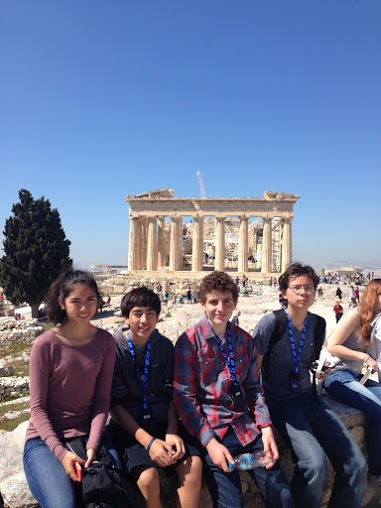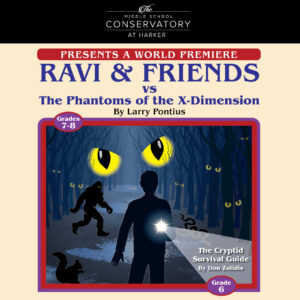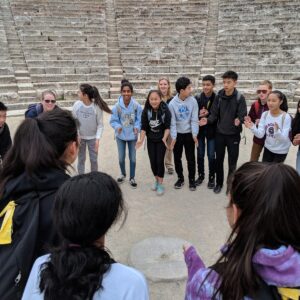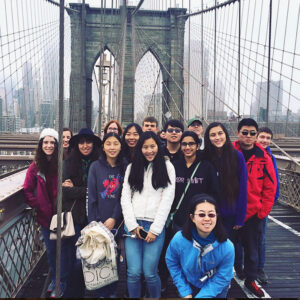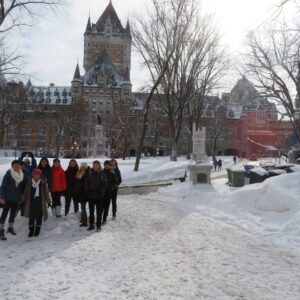Over spring break, a group of 16 Harker history students in grades 9 and 10 took an amazing trip through Italy and Greece, absorbing the rich history and culture of both countries. The journey gave the students the rare opportunity to see many historical sites in person and hear the fascinating stories behind them.
The students, accompanied by upper school world history teacher Andrea Milius and upper school dance teacher Karl Kuehn, arrived in Rome after a 12-hour flight. They checked into their hotel, then headed off to dinner, which included authentic Italian pizza and fried mozzarella. The next day they ventured to the famous Trevi Fountain and Piazza Venezia before heading to Piazza Navona for gelato. After trekking through the city and sampling more local food, they headed to the Spanish Steps for a bit of shopping, then to the Piazza Del Popolo to take in some local scenery.
A highlight of the day was a trip to Vatican City, where the group toured the lovely gardens and a museum filled with papal carriages that had been used in the last several centuries to protect the pope on international visits.
While visiting the Vatican’s renowned art galleries, the students viewed works such as the sculpture of “Laocoon and His Sons.” They also got an up-close look at the many paintings adorning the walls and ceilings of the Sistine Chapel, including the famous works of Michelangelo and Botticelli, and took a stroll through St. Peter’s Basilica, which houses Michelangelo’s sculpture of “Pieta.”
Following lunch at St. Peter’s Square, they explored the Domitilla Catacombs, which Milius observed “were comprised solely of volcanic ash, which we could scrape off with our fingernails.”
Day three started with an extensive guided tour of the Colosseum, followed by a walk past the Arch of Titus, the Temple of Vesta, the Temple of Castor and Pollux, the Senate House and more.
Their hike through Rome continued with stops at the Castel Sant’Angelo (the burial site of Hadrian, one of the “Five Good Emperors”), the Palazzo delle Esposizioni museum and Via del Corso. The day was capped off by another delicious meal.
On the fourth day of the trip, the students traveled by bus to Naples, where a spectacular view of the Mediterranean Sea awaited them. The group took a boat to the nearby island of Capri, where they admired its amazing rock formations and learned about its history as a popular vacation spot for Roman emperors and home to authors such as Norman Douglas, Friedrich Alfred Krupp and Axel Munthe.
At Capri Village, the group explored the various shops and purchased products made from lemons, a fruit for which Capri is particularly famous. They then boarded a boat bound for Sorrento, where they stayed the night. After unloading their luggage, they enjoyed dinner and a sampling of Sorrento’s nightlife.
“It was awesome,” reported Nikhil Dharmaraj, grade 9, “We bought many different things, like ties, tea cups, leather gloves, sunglasses and clothes for great prices. We even saw a mini puppet show!”
The next day, everyone traveled by bus to Pompeii, the city famous for being buried under ash and rock during the 79 A.D. eruption of Mount Vesuvius. The students viewed casts of some of the bodies discovered by archaeologists. Their tour guide gave them a look into Pompeiian daily life and commerce. Later, in Bari, the group boarded a ferry to Greece to begin the second stage of their trip.
On their first day in Greece, the group took a lengthy trip to Delphi, where they explored the narrow streets and local shops, and purchased food to feed the stray dogs they encountered. After dinner, they retired to bed to prepare for the full day ahead.
The next day they saw more of Delphi’s historical sites, including the Temple of Apollo, and learned that Delphi was originally more of a religious center than a city. It was unique in that it was administered primarily by priestesses, who received divinations by inhaling gases and then shared their insights with visiting diplomats and rulers. The group also explored the ruins of the stadium, which was the site for many Olympic games.
En route to Athens, the group admired the Greek countryside and stopped a local restaurant for lunch. Upon arriving, they enjoyed a short walk through the town square and briefly explored the city. Following dinner, they took a guided tour of the legendary Greek Orthodox church, the Metropolis.
While in Athens, the group toured numerous landmarks, including the statues of important Greek Civil War-era politicians and the Tomb of the Unknown Soldier. At the Acropolis, known first as a citadel for Athens and later as a place of religious significance, the students saw many statues and other sculptures that once sat in the structure.
“While many of the statues were damaged in some shape or form, we were able to see how careful the sculptors were in constructing them,” observed Brian Park, grade 9.
For more details and photos from this trip, visit the Italy and Greece student blog!
